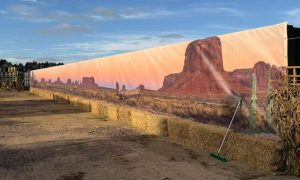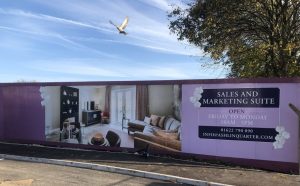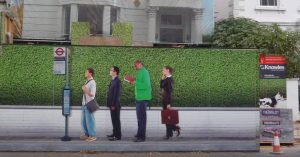Photographic Building wrap are getting more popular and affordable as the digital print price has come down in the past few years. We can wrap with a digitally printed mesh or PVC material, buildings, towers, sky scrapers or scaffold structures for atheistic or commercial reasons.

Photographic Building wrap is a digitally printed mesh banner wrapped around a sub-frame which has been installed around a building or structure.
The Photographic Building wrap can be as big as you want, literally covering the whole building however it’s not to be taken lightly as sub standard print or installation could be very dangerous.
If managed by a professional company like Project Print Management, the printed building wrap are perfectly safe and very impactful.
We have worked on projects to install a photographic building wrap on the Everton Football Club stadium, The Monument, Tate Britain, and for Channel 5 to name but a few.
Bredan Perring of Signlink magazine on Photographic Building wrap
In an interview with Bredan Perring of Signlink magazine Justin Murray talks about the challenges faced when tasked to produce a building wrap.
Building and scaffolding wraps are often visually arresting and high impact. Brendan Perring explores the continued obstacles to this sectors growth and the best materials and techniques from those in the know.
As I walked round the bend of my local high street recently I did a double take as a ripple ran across the front of a high-rise building. Rather than the realisation of the Matrix, it was simply a building wrap using CGI (computer generated imagery) to provide a highly realistic finish.
A few years ago the building and scaffolding wraps sector of the industry saw a boom in high-profile applications, and while it has continued to grow slowly, it has not quite fulfilled its potential.
The main reason for this slow uptake is that it is unable to generate a major revenue stream within our urban areas and continues to remain largely an aesthetic covering for building or restoration work – hamstrung by stringent planning laws.
This said, some of its major players are pushing it new and more revenue friendly directions.
Obstacles to growth for Photographic Building wrap
Justin Murray says building and scaffolding wraps are still mainly used for hiding scaffolding and as decorative pieces
One company that has been trying to bang the drum for building and scaffolding wraps has been Godalming based Print Project Management. But as senior consultant Justin Murray explains, it is not an easy task.
“We have seen a boost in enquiries on this time last year as there is more building work going on in general, specifically to do with the 2012 Olympics. But I would say the main bone of contention for us is still planning permission. Building wraps are still mainly used for hiding scaffolding and as decorative pieces, rather than for an advertising revenue stream,” says Murray.
“If a building or scaffolding wrap is within the Westminster boundary you can forget being able to put branding on it, you need planning consultants and a raft of people to work it through. Sometimes you can do retrospective applications and work with the council to gain planning permission once it is up. But we would be a lot busier if the councils were just a little more easy on what is possible,” he continues.
“The principle objection is that the wrap has to be of benefit to the community and has to enhance the local environment. It does happen that building wraps are approved, such as the Fort Dunlop site, but that was only because it was on the M6 and hiding a building that was in disrepair.”
So how are Photographic Building wrap made?
PPM use a HP Scitex XL1500 super wide format printer with a 5 meter width. And carry out most of their jobs using Neschen’s polyester based ‘SolvoTex PVC Supreme Mesh’, which weighs in at 350g/m2. And the company’s highly realistic output is made possible through the use of CGI technology to re-create building facias for the printed graphics.
As Murray points out, the sectors other major problem is the use of low-grade materials by companies that do not have the skills or expertise to carry out the job correctly – which leads to shoddy work that further entrenches councils and local authorities anti-wrap mentality. Neschen says the key strengths of any substrate being used for building and scaffolding wraps has to be ‘ultra-durability, fungus and UV resistance, and double-sided printing capability’.
“We personally use materials with good fire rating and tear strengths. Allot of the cheaper stuff coming out of China doesn’t weld particularly well, and god forbid if there was an issue, it would be very difficult to get an audit trail back to ascertain liability. I would like to think this sector was going to get bigger, but whether the councils will relax I don’t know,” concludes Murray.
For some of our latest building wraps project please visit our blog page. or for information on our Trompe l’oeil Building wrap click here.





